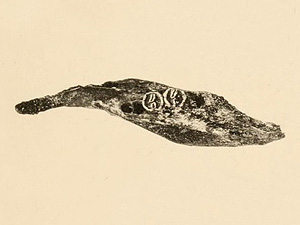Oriente cave rat facts for kids
Quick facts for kids Oriente cave ratTemporal range: Holocene
|
|
|---|---|
 |
|
| Conservation status | |
| Scientific classification | |
| Genus: |
Boromys
|
| Species: |
offella
|
The Oriente cave rat (Boromys offella) was a type of rodent that is now extinct. It belonged to the family Echimyidae, which includes many kinds of spiny rats and other rodents. This rat lived only on the island of Cuba, meaning it was endemic there.
Its natural home was in warm, wet forests found in low-lying areas. Scientists know about the Oriente cave rat from fossils found recently. It likely disappeared after other types of rats were brought to Cuba.
Contents
What Was the Oriente Cave Rat?
The Oriente cave rat was a small mammal, part of the large group of animals called rodents. Rodents are known for their strong, constantly growing front teeth. The Oriente cave rat was a unique species, meaning it was the only one of its kind. It was discovered and named by a scientist named Gerrit Smith Miller Jr. in 1916.
Where Did It Live?
This special rat lived only on the island of Cuba, which is in the Caribbean Sea. It preferred places with lots of trees and moisture. These areas are called subtropical or tropical moist lowland forests. Imagine a warm, humid forest with many plants and a rich environment. This was the perfect home for the Oriente cave rat.
Why Did It Disappear?
The Oriente cave rat is now extinct. This means there are no more of these animals left alive anywhere in the world. It is believed to have become extinct relatively recently, likely after the year 1500.
The Arrival of New Species
Scientists think that the main reason the Oriente cave rat disappeared was because new types of rats were brought to Cuba. These new rats might have been black rats or brown rats, which often travel with humans. These new rats were probably stronger competitors for food and living spaces. They might also have carried diseases that the native Oriente cave rat could not fight off.
Learning from Fossils
Most of what we know about the Oriente cave rat comes from its fossils. These are the preserved remains or traces of ancient life. By studying these fossils, scientists can learn about the animal's size, what it ate, and where it lived. The fossils of the Oriente cave rat tell us about its existence before it vanished.
The Importance of Endemic Species
The Oriente cave rat was an endemic species. This means it was found naturally in only one specific place, which was Cuba. Endemic species are very important because they add to the unique biodiversity of a region. When an endemic species goes extinct, it is a permanent loss to that specific ecosystem and to the planet's overall variety of life.
Protecting Unique Animals
The story of the Oriente cave rat reminds us how important it is to protect animals that live in only one place. When new species are introduced to an area, it can sometimes cause big problems for the native animals. Conservation efforts today try to prevent such extinctions by managing habitats and controlling invasive species.
See also
 In Spanish: Boromys offella para niños
In Spanish: Boromys offella para niños


